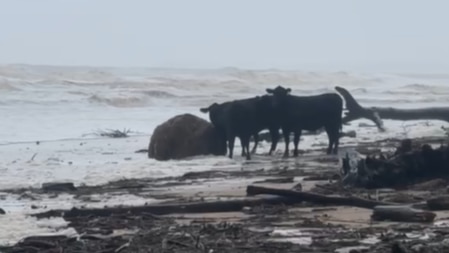Australia Weather News

Livestock reach the relative safety of Old Bar Beach after being washed down Manning River. (Supplied: Ebony O'Connor)
Record-breaking floods along the NSW Mid North Coast and Hunter regions have left dairy farmers isolated, with stock losses and terrible conditions for their cows.
Flood heights are at record levels in many areas of the region, with Wingham, Taree and Croki the hardest hit so far.
The area has received about five times its monthly rainfall to create a new annual rainfall record.
Tragically for farmers and the animals, livestock have been washed into floodwater.
A handful of black Angus cattle emerged on Old Bar Beach, just south of the ocean entrance to the Manning River on the Mid North Coast.
Another lone animal emerged from the dunes into Ingenia Holiday Parks Old Bar Beach on Wednesday morning.
"I was just laying on my bed, in my motorhome and I glanced out the window and a big old cow ran past and seemed quite stressed," park visitor David O'Halloran said.
"They are washing out of the Farquhar Inlet, down the Manning River, which leads out to the ocean," Mr Halloran said.
"Several locals are around, trying to catch the others in the public park area."
A 'diabolical' situation
At Belmore River on the Mid North Coast, dairy farmer Sue McGinn described conditions as "diabolical".
Ms McGinn said farmers across a large area needed help.
She said she and her husband had been struggling since March when ex-Cyclone Alfred dropped significant rain on their property.
Then they were hit by a "rain bomb" that dumped 200mm of rain in the middle of the night on May 3.
Dealing with the mud, constant feeding and caring for cows, animal rescues and now a flooded house has worn them down.
"We are absolutely physically exhausted," Ms McGinn said.
"We feel like we're wrecking our cows, we're wrecking our farm, we're wrecking our plant and machinery and we're wrecking ourselves.
"We've milked here for 31 years and we've been through the 2022 flood and I thought that was a catastrophe but this is like nothing else."
Ms McGinn said the feed situation would worsen over the next two months of winter.
Barrington dairy farmer James McRae agreed.
"We are going to lose quite a lot of pasture this year and if it stays wet it's going to be really hard to get that pasture re-sown before the cold weather," he said.
"We're looking [at] a tight feed spot for the next six months or so, which is not so good with the current hay situation with the drought down south."
Ms McGinn has been contacting farm groups and government agencies to advocate for support.
"God help everybody that's impacted by this, my only hope is that the government understands how much pain we're in," she said.
Fifth-generation dairy farmer Craig Emerton and his wife Debbie said they were isolated on their property at Croki.
Mr Emerton said they were in dire straits with water up to their knees in the house, little remaining food and no way out.
"It's totally unprecedented … we have cattle on the highest part of the farm standing at their bellies in water [with] nowhere to go," Mr Emerton said.
"We lifted all our major furniture up in preparation but the water's come up three times higher than what we've ever experienced."
The state and federal governments announced relief for 16 local government areas in the Hunter and Mid North Coast under the NSW Government’s Natural Disaster Declaration and the Commonwealth-state Disaster Recovery Funding Arrangements.
Assistance includes freight subsidies for primary producers to help transport livestock and fodder and concessional rate loans.
More than 270 millimetres of rain fell in the Barrington Tops in 24 hours and farmers were reporting damage worth more than $100,000.
Barrington dairy farmer James McRae hoped the government would make cash grants available, which happened after significant flooding in 2021.
"I think in the immediate aftermath those natural disaster recovery grants were essential," he said.
ABC